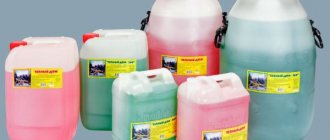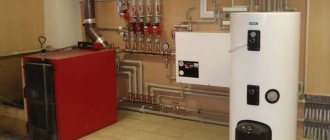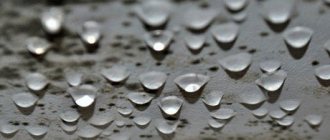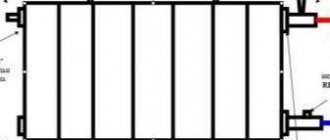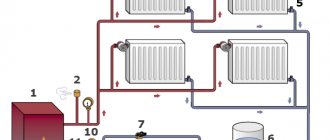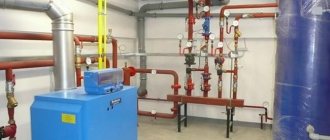Gradual corrosion of metal on the inner surface of pipes and radiators in the heating circuit, crystallization of salts in the coolant, lead to clogging of the heating system and a decrease in its overall efficiency.
Regular flushing of the heating system to remove foreign particles from the heating circuit will help prevent this.
How to clean the heating system in a private house yourself: a review of excellent methods
Comfortable warmth in your home in most cases depends on the constant operation of the heating system. In this regard, heat supply maintenance is considered the key point.
One of the most important options for caring for a heating system is washing the pipes and elements of the heating system.
You may immediately have several reasonable questions:
— Why wash the system?
— Is it possible to make this working volume independently?
— What are the methods for flushing heat supply?
The purpose of this article will be detailed and comprehensive answers to the questions that have arisen.
Design Features
Mud traps for heating systems externally represent a pipeline expansion unit with water filtration using a special mesh and changing its direction. Under the mesh, medium and large suspended particles are cut off, precipitated, and subsequently accumulated.
Dirt traps must be installed in such a way that they provide easy access for cleaning and inspection. In most cases, they are installed at TP control units and building inputs.
When it is necessary to flush
Cleaning the heating system will be necessary if you see the following signs in the operation of the heating supply:
- a drop in temperature in the home when the boiler is constantly operating;
- the pipes heat up excessively slowly;
- heating parts heat up unevenly;
- the pipe lines are hot and the heating devices are cold;
- Fistulas often begin to appear in the pipes, and sometimes ruptures occur.
The manifestation of at least one of these signs may indicate that the heating system is clogged.
Specifications
| Mud collectors for heating systems | |||||||||
| Conditional diameter, DN | Weight | Conditional pressure | D.H. | DH1 | DH2 | H | H1 | h | L |
| 32 mm | 201.9 kg | 1.6 MPa | 159 mm | 32 mm | 32 mm | 1120 mm | 1168 mm | 700 mm | 850 mm |
| 40 mm | 16.3 kg | 1.6 MPa | 159 mm | 40 mm | 45 mm | 360 mm | 406 mm | 260 mm | 345 mm |
| 50 mm | 19.4 kg | 1.6 MPa | 159 mm | 57 mm | 57 mm | 410 mm | 456 mm | 290 mm | 365 mm |
| 65 mm | 29.4 kg | 1.6 MPa | 219 mm | 76 mm | 89 mm | 490 mm | 534 mm | 340 mm | 425 mm |
| 80 mm | 33.5 kg | 1.6 MPa | 219 mm | 89 mm | 108 mm | 525 mm | 569 mm | 375 mm | 425 mm |
| 100 mm | 62.2 kg | 1.6 MPa | 325 mm | 108 mm | 133 mm | 620 mm | 662 mm | 450 mm | 525 mm |
| 125 mm | 70.4 kg | 1.6 MPa | 325 mm | 133 mm | 159 mm | 690 mm | 732 mm | 470 mm | 525 mm |
| 150 mm | 118 kg | 1.6 MPa | 426 mm | 159 mm | 194 mm | 875 mm | 928 mm | 550 mm | 650 mm |
| 200 mm | 266.7 kg | 1.6 MPa | 530 mm | 219 mm | 273 mm | 1105 mm | 1163 mm | 700 mm | 850 mm |
| 250 mm | 266.7 kg | 1.6 MPa | 530 mm | 219 mm | 273 mm | 1105 mm | 1163 mm | 700 mm | 850 mm |
Why does pollution appear?
Corrosion is considered to be the problem with clogging of pipelines made of metal. Accumulating in the middle of the system, it interferes with the free circulation of the coolant, and as a consequence, interruptions occur in the operation of the water-type heating system.
As for plastic pipes, they are naturally not prone to rust, but still, scale appears on their walls, which also helps the heating system malfunction.
One of the causes of pollution is also considered to be the quality of water, which contains various impurities that are the basis for clogging of pipes.
Similarly, there are the following blockage options:
Coarse filter
The filter is installed when connecting the heating system to the central water supply. It is a flask with a filter element inside. The connection can be flanged or coupling, depending on the diameter of the water supply pipes. Necessary for filtering large contaminants. Effectively retains dirt, sand, large abrasive impurities. It will reliably protect the heating system from large elements, but will let small ones through. It is also not capable of chemical cleaning or water softening. He cannot purify the water to the desired state on his own. Doesn't take up much space. The coarse filter is the first line of defense for your home's water supply.
How often to clean your heating system
Most people who carefully care for their own heating system ask themselves how often to clean the pipes.
There are several types of cleaning work:
- The first flushing is performed as soon as the heating system is installed. This is due to the fact that when heating equipment was installed, very different types of debris or oily contaminants could get inside the pipes. Due to this, the flushing procedure must be performed until the water in the drain becomes completely clear.
- Constant flushing in systems equipped with pipes made of metal is recommended to occur 2 times a year - before the start of the heating period and after its completion. For plastic pipes, it is recommended to clean them once a year - at the beginning of the heating season.
Knowing now the reasons for contamination of heating systems, as well as the regularity of cleaning, the question instinctively arises: is it possible to do the flushing yourself?
And we will give a positive answer to this: cleaning the heating system can be done with your own hands. To do this, you just need to choose the ideal washing option, which will be discussed further.
You can learn small details about cleaning a gas boiler from soot from this article.
Universal filter mesh
The simplest mesh filter for heating. It consists of a body (metal) and a cylindrical mesh located inside the flask. The housing is closed with a plug or tap, depending on the type of filter. Connection system - flange. There are washable and non-washable filters. Non-flush ones must be replaced at the end of their service life. The washers last a long time thanks to cleaning. It is necessary to stop the water circulation, dismantle the cover, remove and wash the mesh, and install it. In addition to its relatively low price, the mesh is attractive due to its simple design, easy maintenance and cheap components. This filter is installed in front of the fine cleaning system. This is the penultimate level of protection. Serves to purify water from scale or solid inclusions. Pipe fittings or pumps damaged by scale will cost tens of times more than a cheap filter. The filter does not take up much space.
Washing methods
Nowadays, there are usually 4 innovative ways to clean a heating system.
Chemical washing. This cleaning option allows you to remove 100% of system contaminants, with a minimum of effort required. However, this cleaning method is only suitable for pipelines made of heating metal.
To do dry cleaning yourself, you need to have the following materials and tools nearby:
- washing solution, it contains mineral or organic acids, as well as various solvents and alkalis;
- container for draining liquid;
- pump;
- hoses.
The procedure is as follows:
- water is drained from the heating system;
- acid solution is poured;
- a specialized pump is connected to the system, which pumps cleaning liquid throughout the entire heating circuit for several hours;
- the waste liquid is drained and clean water is pumped in.
Hydrodynamic flushing. This method of cleaning the heating system is carried out using special equipment, which includes thin hoses and specialized nozzles.
The principle of cleaning with this method is that water is supplied under pressure to the nozzle, which produces thin jets of water. With the help of these jets, all grease, corrosion and scale are removed from the work area.
It should be noted that although this method of flushing pipes is considered very practical, due to its high cost it is used very little.
Pneumohydropulse flushing of the heating system. In order to do this cleaning option with your own hands, you will need:
- air blower;
- branch pipe section;
- hose;
- clamp;
- ball valve;
- drain container.
The working order consists of the following steps:
- water is drained from the system;
- the outlet section of the pipe is connected to the “return”;
- the air blower is connected to the outlet, and we pump up a pressure of about 5 atmospheres. Strong pressure in the pipes leads to a variety of contaminants breaking off from the walls.
- we close the outlet section of the pipe and separate the air blower and connect the hose;
- we open the valve, and ultimately, all contaminants come out under pressure.
It should be noted that for very high-quality cleaning, the pneumohydropulse procedure can be repeated a couple of times.
Read an educational publication about cleaning a heating boiler from scale here.
Watch the video, which explains the need to flush heating systems and the specifics of carrying out certain work:
Additional benefits
The mudguard helps to save fuel. Using this water filter (photo below), you thereby protect the convective elements of the boilers - this, in turn, maintains their high efficiency and does not increase the volume of fuel. Accordingly, there is no excessive fuel consumption, which leads to impressive financial costs.
In addition, the mud filter allows you to change or pump up water in the heating system much less frequently, which also contributes to savings, since there is no need to consume reagents and excess electrical energy. The volume of coolant that is discharged into the sewer system also decreases.
The cost of these devices may vary depending on their type and size. The most common is for water (photo below). On such equipment, a filtration mesh is built into its housing.
How to clean the heating system in a private house on your own step by step?
We are going on vacation for a long time, so we decided to wash the heating system and turn it off. How to properly clean the heating system in a private house?
Flushing heating systems in a private home is a delicate matter and not always appreciated. Unfortunately, you did not indicate in the explanation of the questions what components your heating system consists of (material of pipes and heating devices, what circulation of the coolant is used in the system, where and what type of boiler is installed, whether filters are installed or not) - without such data it is difficult to give The answer to your question is exactly. It will be necessary to tell here only basic tips for flushing heating systems.
In itself, flushing heating systems is an essential necessity, but only in centralized heating systems of apartment buildings and high-rise residential buildings and it increases the operating efficiency of heat supply. Why is flushing most effective only in central heating systems? This is a separate conversation - I will only say that the centralized heating system includes tens of kilometers of profile pipes, thousands of heating radiators, dozens of heating units, heating points and control frames, and it also includes dozens of circular pumps and heat exchangers of boilers and much more. In addition, in such very large, branched systems there are often leaks of the coolant, and boiler systems are forced to work on “feeding” the system with fresh tap water rich in oxygen. In such systems, many elements are made of metal (usually steel and cast iron). so - these metals, when exposed to oxygen (and it is always contained in the water mass) and high temperature, oxidize, corrosion occurs on the internal iron surfaces of heating systems (on steel), a black, oily coating (on cast iron) - it is natural that The coolant carries these deposits throughout the system, and they settle in the narrowest places, thus creating traffic jams.
It is to remove such plugs that the central heating system is washed.
In individual residential buildings, the picture is completely different, because there the length of pipelines is small, and the system itself is much lighter and more compact than a central heating system. Therefore, the likelihood of traffic jams forming in such a system is quite low, especially if new materials and equipment are used in the heating system (pipes, heating devices, filters, etc.) And the question - is it really necessary to flush heating systems in such houses - is quite ambiguous . On the Internet there is a lot of advice and advice on flushing from people who are absolutely incompetent in this matter. Whether it is necessary to flush the heating system in a private house is up to the owner of the house to decide. After all, he alone knows what elements his heating system consists of, what is used as a coolant, how and how long the system does not stop working (whether there are any failures to warm up), etc. The decision to wash or not to wash is made on a case-by-case basis.
When there is no need to wash the heating system:
- If the heating system is new, it does not stop working for less than 5 years.
- If there are no complaints about the operation of the system
- If the filter (mesh) on the return line at the end of the heating period is clean
- If the system uses pipes (PP) - polypropylene, or metal - plastic (plaque does not appear in such pipes)
- If the system does not have cast iron or steel radiators.
In any other situation, the system can be washed as a warning, but without fanaticism. Don’t listen to the “smart guys” who recommend cleaning the system with chemicals (especially acid-based ones). Chemical flushing can significantly reduce the service life of heating systems. Wash with ordinary tap water under pressure of 2 - 4 atm (pressure of the water supply network). The duration of the procedure is until the purest water flows from the return.
Flushing heating systems in an individual house in stages (one type):
- We drain the coolant from the system through the return valve.
- We close the supply and return valves at the boiler (if you have them installed) - it is not best to drive all the sludge through the boiler.
3. Turn off the expansion tank.
- We cut a pipe into the supply pipe to connect it to a 15 valve at the end (similar to a relief valve on the return)
- We use a bendable hose to connect the valve on the supply with the valve on the water pipe.
- We put a rubber hose on the discharge pipe for connection on the return line and attach it with a clamp. We take three ends of the hose out into the street or into the sewer.
- Open the valve to 15 on the supply and the drain valve on the return
- We open the valve on the water pipe and wash the system until the purest water flows from the return line.
- We close the relief valve, remove the plug from the expansion tank, and recharge the system to the required level. We turn off the water supply mixer to the system.
In very severe cases, you can add biological reagents (extract) to the heating system and drive the coolant through the system (including through the boiler, of course) within 24 hours using a pump (if you have one), you can also warm up the system - if there is no pump. Then you need to drain the coolant with the reagent and wash the system with drinking water.
If this method does not help, then it is easier to replace “clogged” heating devices and pipes.
Cleaning away limestone deposits
To ensure that risers do not deteriorate from the inside, are used for a long time, do not reduce thermal conductivity, and also have an attractive appearance, it is necessary to regularly clean them of limestone deposits.
Mechanical and chemical cleaning are considered not very effective, since during their implementation the surface metal layer is destroyed. Plus, during such cleanings it is sometimes necessary to dismantle the system, which is not always pleasant, and from a financial point of view it is not very profitable. In addition, if you use chemical cleaning, you should strictly follow the instructions. Otherwise, you can not only harm yourself, but also harm the environment. Although, many people prefer these methods of protection against scale.
To carry out automated cleaning of pipes from rust and limestone deposits, use:
Compressor for purging
- compressor;
- automatic pump;
- high pressure devices.
With the help of a water or air jet supplied by these mechanisms under high pressure, limestone deposits are torn off the internal surfaces of the pipes and come out.
Using even the best methods and methods for removing scale in pipes, some of the metal is removed along with pieces of plaque. Therefore, it is better to prevent clogging of structures, for which it is necessary to regularly carry out preventive measures in order to eliminate the possibility of scale formation.
Important! The cost of preventative work to prevent the formation of limestone deposits is much cheaper than the process of cleaning a contaminated pipeline system.
How do you know when rinsing is necessary?
You will understand that flushing the heating systems in a private home will be necessary when you see the following signs in operation:
- the temperature regime in the house has decreased, although the boiler does not stop working stably;
- pipes become warmer slower;
- heating elements heat up unevenly;
- the pipes are hot and the radiators are cold;
- Fistulas in the pipes often began to appear, and ruptures occurred.
The appearance of at least one of these signs indicates that the heating system is clogged.
Causes of pollution
Corrosion is considered to be a common cause of clogging of iron lines. It accumulates in the middle of the system and does not allow fluid to circulate freely. As a result, interruptions occur in the operation of heating systems.
Plastic pipes do not rust, but scale can still form on the walls, which also interferes with the constant operation of the heating system.
Also, the appearance of contaminants is influenced to a certain extent by the quality of water, which contains various impurities.
Therefore, it is necessary to distinguish the following types of blockages:
Varieties
To reduce the risk of boiler breakdown, increase the accuracy of measuring instruments and ensure long service life of the equipment , it is important to understand the main types of devices and choose the right one.
Polyphosphate
Polyphosphate units are considered a budget option for pre-purification and softening of water entering the boiler.
The operating principle of such a device is to pass liquid through a flask filled with special crystals. They ensure the formation of a protective film on the inner walls of the boiler and also slow down the formation of scale.
Photo 1. Polyphosphate filter for a gas boiler, filled with special crystals. They slow down scale formation.
The devices have a simple design:
- drain;
- flask;
- filler;
- lid.
The liquid enters the flask with filler through the lid, where it is passed through polyphosphate crystals. Next, it goes through the drain into the gas boiler tank.
Any device of this type requires periodic replacement of the filler - sodium salt crystals. As a matter of fact, this is the only difficulty in servicing them. The average lifespan of such a treatment plant is up to one and a half years.
How often should you clean your heating system?
If you are asking this question, then you are probably quite careful about your own heating system.
There are two cleaning methods:
- The initial flushing is carried out immediately after the heating system has been installed, due to the fact that during the installation of heat supply, various types of debris or oily contaminants can get inside the pipes. Therefore, the flushing procedure should be performed until the water in the drain becomes clear.
- Experts recommend doing regular flushing in systems that are equipped with pipes made of metal 2 times a year - before the start of the heating season and after it ends. For plastic pipes, it is worth cleaning once a year - at the beginning of the heating season.
That's right, if you are wondering, is it possible to wash a pipe system on your own? The answer is yes. To do this, you just need to choose the best washing option, which we’ll talk about later in the publication.
Mechanical cleaning filter, washing cascade
A flush filter for heating systems is necessary for the mechanical purification of water supplied to a heating system with a working environment temperature of up to one hundred and ten degrees. The filter purifies water from suspended matter, mud and silt deposits, sand, etc. The cascade filter is more compact than other filters with similar functionality. The volume reduction was achieved thanks to the latest nested filter system. Two filter elements of different sizes are placed one inside the other, and the vertically directed water is twisted into a spiral and is effectively cleaned of mechanical impurities. The device is installed strictly vertically. Cleaning the filter elements is quite simple; there is no need to remove the mesh inserts. The body and bulb are most often nickel-plated. Filter elements made of stainless steel. The filter does not take up much space. Simple and reliable in operation.
Flushing options
Several innovative options for cleaning dirt are now known. Let's consider flushing agents for heating systems.
Chemical
This cleaning method is a 100% removal of system contaminants with minimal effort. However, this option is only suitable for heating pipes made of metal.
Effective heating circuit flushing agent
To perform chemical washing on your own, you will need the following materials and tools:
- washing solution;
- various solvents and alkalis;
- container for water drainage;
- pump;
- hoses.
Step by step the work looks like this:
- Drain liquid from heating systems.
- Pour in the acid solution.
- A special pump is connected to the system, pumping cleaning liquid throughout the entire heating circuit for several hours.
- The waste water is drained and clean water is pumped in.
Do not forget that the acid solution is not allowed to be poured into the sewer. When it is not possible to recycle it yourself, you can purchase special means of neutralization.
And don’t forget that you can’t wash aluminum heating appliances with acid, because they can also cause great harm.
Hydrodynamic
Another answer to the question of how to clean the heating system in a private house.
This method involves the use of specialized equipment, including thin hoses and special nozzles.
Hydrodynamic flushing of pipelines
The cleaning principle is such that water is supplied under pressure to a nozzle that generates thin jets of water. With the help of such jets, all grease, scale and corrosion are removed from the work area.
The hydrodynamic pipeline flushing option, although quite effective, is rarely used due to its high cost.
Pneumohydropulse
An additional option for flushing heating systems. For this type of pipe cleaning on your own you will need:
- air blower;
- clamp;
- branch pipe section;
- ball valve;
- hose;
- container for draining.
Pneumohydropulse washing is done step by step:
- First of all, drain the water from the system.
- The outlet section of the pipe is connected to the return circuit.
- The air blower is connected to the outlet, and a pressure of approximately 5 atm is pumped up. Strong pressure helps break off all kinds of contaminants from the walls.
- Close the outlet section of the pipe and disconnect the air blower. Connect the hose.
- They open the valve, and eventually all the debris comes out under pressure.
For more effective cleaning, this procedure can be repeated more than once.
Now you know how to clean the heating system in a private house. Do not forget that most of the pollution occurs in those sections of the pipeline that are located next to the heating boiler. Such places are considered areas of greatest temperature impact. And they actually need to be cleaned more often. It’s great to flush your heating pipes every 2-3 years. As statistics show, home specialists carry it out once every 5-6 years. This is allowed.
When the heating system has not been cleaned for 10-15 years, it is necessary to first dismantle the heat exchangers of the heating unit and all standing heating devices. There is no need to dismantle or remove the pipes. And further. After you wash the pipe wire, calculate the condition of the clamps and threaded fittings that are installed on the line. Very often they are affected by scale and corrosion. When the dirt is small, simply remove it. If the fittings cannot be cleaned, replace them with new parts. These are the rules for flushing heating systems.
Flushing the heating system
Soft radiator cleaning
Cooling maintenance (including flushing and replacing antifreeze) is not particularly difficult, so it is quite possible to perform such work without contacting specialized workshops. You don’t even need to purchase special auto chemicals if you use citric acid or ordinary distilled water to remove existing internal deposits.
It is recommended to gently flush the system annually using distilled water. To do this, you need to drain the antifreeze from the radiator and engine crankcase and pour it into the expansion tank, which will reduce the cost of operating the equipment. Using distilled water, you can remove existing contaminants that accumulate in the lower part of the radiator and impair the cooling efficiency of the power unit.
The car owner will need to drive the car onto a level area. It is best to flush the VAZ cooling system with citric acid on an overpass or in a garage pit. The old coolant is drained from the engine by unscrewing the drain plugs on the cylinder crankcase. After this, remove the lower radiator pipes and wait until all the antifreeze drains into a specially prepared container.
Then tighten the drain plugs and install the radiator pipes in place. Distilled water or a prepared special solution based on soda, citric or lactic acid is poured into the tank. The system is pumped to remove air pockets and allow fluid to circulate through the large and small cooling circuits.
Start the engine and let the engine run for about 5 minutes. After this, the unit is shut down, cooled, and distilled water with various small contaminants suspended in it is drained from the crankcase and radiator.
All that remains to be done is to pour antifreeze into the system, bleed the pipes, removing all air and air pockets, after which you can operate the engine without problems for one to two years until the coolant is replaced and the radiator is completely cleaned of dense contaminants and calcium deposits. The latter can only be eliminated using citric acid and other similar means.


